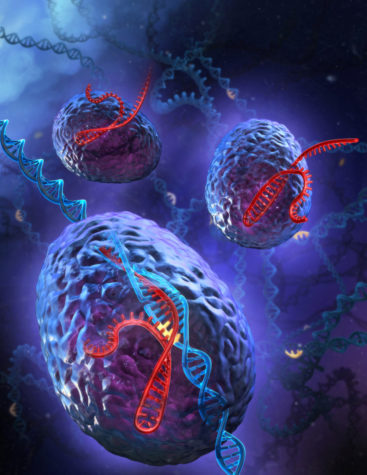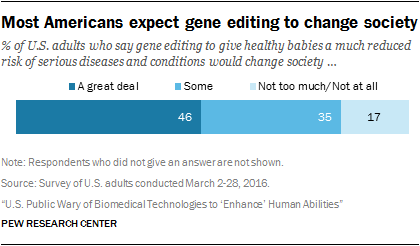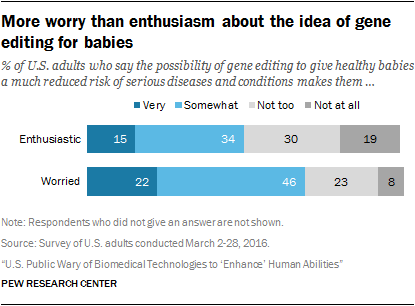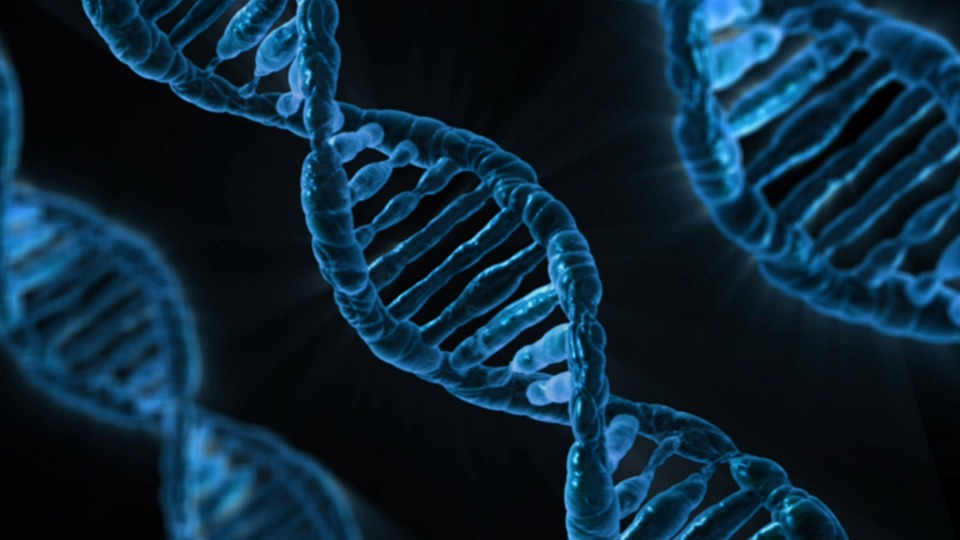Gene editing: Will it really save lives?
November 7, 2019
Imagine a world where HIV patients could be cured of the disease. A world where you could permanently change your eye color and hair color. A society where everyone has been genetically modified.
What if you became a parent one day? You have a daughter or a son, and are given the opportunity to change them in ways you wouldn’t think were possible. You have a child born with a disease, but you have the choice to remove that disease forever. Now, you can live freely without worrying about your child.
What if you had the most adorable little puppy or kitten, but it was born deformed or with unusual features? You would do anything to have your pet live as comfortable a life as possible, maybe even to the extent of performing a gene surgery on it to perfect certain features.
Well, all these scenarios aren’t fantasies at all. They are realities that can be possible in today’s world. With new innovations being invented yearly, an advancement was finally made to match these extraordinary ideas.
Gene editing is that advancement that has changed the nation. It is a turning point in the genetic engineering industry. It has opened up many new views in the medical field. However, with new technology comes different opinions. Some believe gene editing is ethical while others don’t.
At a Ted Talk, biochemist Jennifer Doudna, who took part in inventing a potentially world-changing genetic technology, the gene editing technology CRISPR-Cas9, said, “The opportunity to do this kind of genome editing also raises various ethical issues that we have to consider, because this technology can be employed not only in adult cells, but also in the embryos of organisms, including our own species.”
What is gene editing?
Gene editing is a type of genetic engineering where DNA is added, removed, or altered at certain locations in the genome.
The idea of gene editing is nothing new. It has been an idea since the 1970s, and we’ve had the technology for copying, sequencing, and even manipulating DNA.
Gene editing has been used in many situations. For example, gene editing is used to edit crops, helping the food industry. Crops such as tomatoes, watermelons, corn, strawberries, and so many more, have been genetically modified.
Gene editing has also created many possibilities in the medical field which helps improve the lives of numerous living organisms. One situation in the medical field, that is still occurring, is scientists trying to genetically modify mosquitoes. Though they might be small, mosquitoes are considered one of the most dangerous animals in the world. This is because they carry and spread diseases that kill millions of humans each year. Scientists hope to genetically modify mosquitoes to combat diseases like the Zika virus, Dengue fever, and Yellow fever.
There are things constantly being improved and invented in the genome industry. Currently the industry is working on developing new technologies to examine genes and DNA on a large scale, being able to accumulate genomic data efficiently, continuing to explore concerns about gene editing, and applying genome strategies in order to detect, diagnose, and treat diseases.
Gene editing in the real world
One of the most revolutionary advances in gene editing has been CRISPRs. CRISPR stands for Clustered Regularly Interspaced Short Palindromic Repeats. This innovation has generated excitement throughout the scientific community because CRISPRs serve as a faster, cheaper, more accurate, and more efficient method than other genome editing tools in the industry. There are many applications possible, such as correcting genetic defects, improving crops and food, and preventing and treating the spread of diseases.

CRISPR consists of a variety of CRISPR-Cas 9 and other systems. With this tool, scientists can permanently modify genes of cells of living organisms, and in the future, scientists can possibly fix mutations in specific locations in the human genome to cure diseases.
How were CRISPRs first discovered? CRISPRs themselves were first discovered in archaea by Francisco Mojica, a scientist at the University of Alicante in Spain. He suggested that CRISPRs defend against viruses.
In January 2013, the Zhang laboratory, which focuses on developing and applying molecular technologies to study the nervous system, made the first method of engineering CRISPR to edit genes in human and mouse cells.
With this advance technology, CRISPR-Cas 9 is an efficient and customizable method compared to other current gene editing tools. Usually, gene editing tools need to be paired with a separate enzyme, but CRISPR-Cas 9 itself is able to cut DNA strands. Yet another great aspect is that it is also able to target multiple genes at the same time.
The world’s first gene edited babies
China has been a place where many innovations and experiments have occurred. It began with Chinese scientists cloning a female goat in 2000. As the years went by, they had succeeded in creating the world’s first primate clones. Scientists edited monkeys’ embryos to insert genes dealing with mental illness and autism. This was followed by the creation of unusually strong dogs. Recently, the world was shocked when a Chinese scientists admitted into creating the world’s first genetically edited babies.
It all started on June 10, 2017. It was a warm Saturday in Shenzhen, China, when two Chinese couples arrived at the Southern University of Science and Technology to discuss if they wanted to participate in a medical experiment that no researcher has ever dared to carry out. The couples were going through fertility issues, so they sat in a conference with He Jiankui, a biophysicist of the Southern University of Science and Technology.
Jiankui was well-known throughout China, but not as much outside the country. Jiankui told the couples how the experiment wouldn’t be an easy one. He said, “We want to tell you some serious things that might be scary.” Caution needed to be taken. As the discussion went on, Jiankui and his postdoc went through informed consent forms with the couples.
Jiankui said, “I feel a strong responsibility that it’s not just to make a first, but to also make it an example. Society will decide what to do next.” This claim astonished scientists worldwide. Dr. Kiran Musunuru, a University of Pennsylvania gene-editing expert responded with, “It was unconscionable…an experiment on human beings that is not morally or ethically defensible.”
At the end Jiankui ended up altering embryos for eight couples with one pregnancy resulting. Jainkui’s goal was not to prevent or cure an inherited trait, but rather to try to present a trait that most don’t have: the ability to resist future infection with HIV.
Then, in October 2018, a breakthrough was finally made. The Chinese twins Lulu and Nana were born, the world’s first gene-edited babies.
However, it wasn’t until November 25 where He Jianki released the details of his work at a Hong Kong conference.
At first, Jiankui’s research was seen as an incredible scientific advancement. For instance, People’s Daily Online, one of the most influential newspapers in China, referred to Jiankui’s experiment as “a historical breakthrough in the application of gene editing technology or disease prevention” (SinaTech 2018).
As more details arose during the Hong Kong conference, bioethicists, scientists, lawyers, and the general public worldwide challenged the experiment’s legitimacy.
The Scientific Ethics Committee of the Academy of Sciences declared that “the theory is not reliable, the technology is deficient, the risks are uncontrollable, and ethics and regulations prohibit the action.” Ren-zong QUI, a high-ranking Chinese bioethicist, said Jiankui’s research was “a practice with the least degree of ethical justifiability and acceptability.”
The general public also had various opinions on He Jiankui’s research. Most people were concerned about the well-being of the twin girls Lulu and Nana and the potential consequences that would come to humanity.
Response to the backlash
After Jiankui released his claims without any real evidence, the Chinese government started an investigation on Jiankui’s claims. Authorities wanted to suspend Jiankui’s research, staying it was “extremely abominable in nature” and it violated the laws and ethics of the nation. Authorities also suspended Jiankui from the institution he worked in.
Later on, it appeared to seem that He Jiankui was missing. However, it was confirmed that he was staying in a government-owned apartment, most likely as a form of house rest.
The debate rises
Although there have been many situations in the world that has used gene editing, the question still arises: is gene editing really saving lives? Should it be allowed? One side supports gene editing, while the other is against it. There is good reasoning to both sides of the story.
The supporting side
Supporters of the use of gene editing argue that gene editing could possibly reduce, or even eliminate the occurrence of many serious genetic diseases. Cells can be protected from viruses not only in one generation, but many generations of cells. This can reduce human suffering worldwide.
For example, CRISPR-Cas9 makes it possible to treat and prevent complex diseases such as heart disease, cancer, mental illness, and HIV. Scientists in Philadelphia have shown that it can be possible for them to use CRISPR to take out the DNA of an HIV virus from infected human cells.
Furthermore, the use of gene-editing technology to edit different types of blood cells, like hematopoietic stem cells, has served as an important component of therapeutic development for the hematopoietic disease. Although these technologies help provide for patients suffering from diseases, the process on human cells is still relatively new.

In addition, gene editing could be used to treat and possibly prevent a common hereditary disease: sickle cell disease. According to the US Centers for Disease Control and Prevention, sickle cell disease affects 100,000 people, and it occurs in one out of 365 African-American births.
For communities like this where there is a common genetic disease, gene editing would be of tremendous help to save many lives.
Gene editing could even help the military. In an advanced world, soldiers with the ability to withstand many types of diseases, harsh weather, and be stronger physically can actually happen with the technology our nation has. With physically stronger soldiers, it would possibly be easier to engage in a battle if there were one.
These potential uses open up numerous questions about its effect on society.
The opposing side
Those who are against the use of gene editing on human embryos say that although gene editing provides many benefits it also has many concerns that it brings up.
Safety concerns
Gene editing hasn’t been perfected yet as a practical method to use, so safety is a primary concern. There is possibility of off-target effects (edits made in the wrong area) and mosaicism (when some cells have the edit but others don’t). Researchers and ethicists who have spoken about this issue agree that until gene editing is 100% proven to be safe, it shouldn’t be used for clinical reproductive reasons.

People are also concerned that gene editing for reproductive purposes will be managed differently between the United States and in other countries, resulting in the method being used in ways U.S. Americans don’t find proper.
Gene editing is not something that has proven to work safely at all times. Tools in the genome industry are still always being made and remodeled. With this new technology, not many have put it to use, so its benefits and consequences aren’t clear. It isn’t always absolutely know what exactly can happen during a procedure. Gene editing on human embryos is new technology that isn’t perfected, and much is still unknown about it, making the method risky.
The dangerous risks cannot be accounted by the possible benefits.
Informed consent
Another concern of the public is informed consent. Many worry that it’s impossible to get informed consent because gene editing is being performed on human embryos, or in other words, future generations. It wouldn’t be fair if the child being performed on didn’t even get to have a say on the procedure, especially since the risks aren’t fully understood yet.
In a recently conducted interview, a science teacher, who wishes to remain anonymous said, “I can see the benefits like if someone is going to have a horrible disease, and we can edit that out, that’s awesome. However, you get into some ethical problems like who are we gene editing, what traits are we editing out, and can it be used for something bad.”
Social concerns
Furthermore, gene editing can affect society as a whole. It can cause divisions among people in a community. Similar to many new technologies, gene editing will only be available to the wealthy. The National Human Genome Research Institute said, “Some worry that taken to its extreme, germline editing could create classes of individuals defined by the quality of their engineered genome.”
Not everyone will be able to have the embryos modified due to how expensive gene editing will be. This can create a society where people born with genetic conditions are less likely to be accepted. They will be looked down upon just because they did not get genetically modified to not have a certain disease or physical feature, for example.
Policy advocacy organizations like the Center for Genetics and Society are concerned that gene editing will “privilege the rich in profound ways, genetically separating them from everyone else, bestowing them with intellectual and physical advantages we can only dream of.”
Harvard researchers say that, “For families who have watched their children suffer from devastating genetic diseases, the technology offers the hope of editing cruel mutations out of the gene pool. For those living in poverty, it is yet another way for the privileged to vault ahead.”
In addition, by opening the door to gene editing, people are opening the door to other kinds of germline modification. John Harris, a professor said,“Permitting human germline gene editing for any reason would likely lead to its escape from regulatory limits…that would exacerbate already existing discrimination, inequality, and conflict.”
By allowing gene editing, problems among numerous issues in society will increase. Gene editing creates more discrimination and elevates already-existing issues within society, making matters worse in a community.
Now, think back to the question you read at the beginning. Have your views changed in even the slightest way? Would you think twice about gene editing yourself, or would you risk it, now knowing that much is unknown about the process.
Every parent wants what’s best for their child. Is gene editing really the safest way to go? If you were a parent, would you still want to edit your unborn child’s genes not knowing if it will result in a magnificent outcome or something terrifying?
A world where incurable diseases were curable is something wonderful to have. Many more lives would be saved because of the gene editing technologies. Even though this is something that would be great for the world, it doesn’t come without all its concerns, whether it’s about safety or if it is ethical.
So many factors are to be considered when talking about gene editing. Both views of gene editing have to be taken into account to come to a final conclusion. Convincing points are presented on both sides of the story, but at the end of the day, the question is: what path would you choose to follow?
